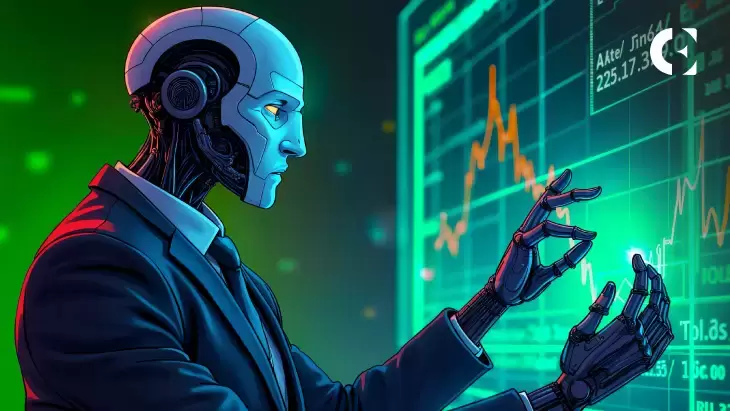 |
|
 |
|
 |
|
 |
|
 |
|
 |
|
 |
|
 |
|
 |
|
 |
|
 |
|
 |
|
 |
|
 |
|
 |
|
Cryptocurrency News Articles
Can AI Predict the Market? Discover How Trading Bots Use Advanced Algorithms to Automate Trades and Potentially Generate Profit
Apr 03, 2025 at 02:30 pm
AI has reshaped a lot of industries since it appeared and it's continuing to do so. The financial market is one of them, which particularly saw a big change

Artificial intelligence (AI) has quickly changed many industries since its appearance and it continues to do so. One industry that saw a big change with the introduction of AI is the financial market.
This market is particularly interesting as it’s constantly evolving and influenced by various factors, presenting a challenge for traditional algorithmic trading. However, trading bots powered by AI could overcome this.
These bots use machine learning, deep learning, and predictive analytics to identify trading opportunities and execute trades at blazing speed (one could say it’s even ludicrous speed). Unlike traditional algorithmic trading, AI-based systems continuously learn from new data and adapt to changing market conditions, making them powerful tools for traders.
However, using AI for market prediction faces challenges and limitations.
Predicting price movements with certainty remains difficult due to the inherent complexity of financial markets, external economic influences, and sudden, unpredictable events (which, considering human nature, is quite often). Let’s just say, the technology just isn’t quite there yet, or rather, people haven’t figured out all the kinks and nuances.
Why AI Struggles with Market Prediction
As one might have gathered by now, predicting financial markets is far from straightforward, probably even more so today with the crypto industry in the mix. Multiple hurdles limit the effectiveness of AI-powered trading systems, starting with the nature of financial markets.
They are complicated and influenced by a combination of several elements, that is, macroeconomic factors, geopolitical events, investor psychology, market sentiment, high-frequency trading, and institutional manipulation.
A key issue is the lack of structured rules; markets lack fixed patterns and are often swayed by unforeseeable events. For instance, a sudden crackdown on crypto exchanges in China or a major economic crisis can drastically shift market trends, which AI struggles to anticipate.
The next set of challenges are data limitations and bias. AI models require vast amounts of high-quality data for precise predictions. However, financial data often contains biases, missing information, or manipulated data that can mislead models.
To give you an example, an AI model trained only on bull market data might perform poorly during a sudden market downturn because it has never encountered such conditions before. Similarly, historical data may not always reflect current market realities due to evolving economic policies and investor behaviors.
Then, there are overfitting and model risks. At first glance, this doesn’t sound like an issue, but overfitting is a common problem in AI trading. It refers to a situation when an AI model performs exceptionally well on historical data but fails in live trading.
Overfitting occurs when models memorize past trends rather than recognizing generalizable patterns. On top of that, large institutional traders actively adapt their strategies to counteract AI-driven retail trading, further diminishing the reliability of predictive models.
How AI Trading Bots Analyze Markets
Despite the challenges above, AI trading bots can still be useful as they use various techniques to generate market predictions. To name a few:
Core AI components like supervised learning, reinforcement learning, and neural networks allow AI to learn from labeled past trading data for future predictions. Through a combination of these, AI learns from labeled past trading data and applies it to future predictions, all the while it continuously improves upon strategies via feedback from simulated trading.
In addition, deep learning techniques recognize price patterns, helping AI detect trends. In summary, these models analyze historical price movements, trading volume, and volatility to forecast potential price actions.
The name perhaps sounds complicated, but it basically involves AI bots scanning news articles, financial reports, and social media to assess market sentiment. Then, by analyzing text data, NLP models gauge investor outlook (bullish or bearish).
For instance, an out-of-the-blue increase in positive sentiment about Bitcoin on social media might indicate an impending price surge. On the other hand, panic-driven discussions may signal a market downturn. NLP understands the context of these conversations, analyzing word relationships between words in a sentence across paragraphs to get the meaning.
This is more technical in nature and is a bit more complicated as AI-powered trading bots rely on a bunch of technical indicators. These include moving averages (MA, EMA), relative strength index (RSI), moving average convergence divergence (MACD), Bollinger Bands, and liquidity analysis.
If you’re not familiar with the terms, you’ve likely read a bunch of gibberish now. Put simply, these signals help AI determine potential entry and exit points for trades by:
Last but not least, AI bots use and analyze alternative data sources to speculate. This could be blockchain data with on-chain transactions, whale movements, and DeFi activity for crypto markets. Also, it employs options market data where open interest and trading volumes help predict investor sentiment.
Moreover, AI even uses Google, specifically Google Trends and web traffic data. It can look for spikes in searches for specific cryptocurrencies or stocks that may indicate upcoming market movements.
Using AI Wisely: Potential vs. Pitfalls
It’s worth remembering that AI indeed is a powerful tool,
Disclaimer:info@kdj.com
The information provided is not trading advice. kdj.com does not assume any responsibility for any investments made based on the information provided in this article. Cryptocurrencies are highly volatile and it is highly recommended that you invest with caution after thorough research!
If you believe that the content used on this website infringes your copyright, please contact us immediately (info@kdj.com) and we will delete it promptly.
-

-

-

-

-

- The global cryptocurrency market took a major hit today, with the total market capitalization falling 5.46% to $2.63 trillion.
- Apr 04, 2025 at 12:15 pm
- This sharp decline was triggered by a broad sell-off following U.S. President Donald Trump’s announcement of new tariffs on trading partners worldwide, sparking concerns about global economic stability.
-

-

-

-




























































